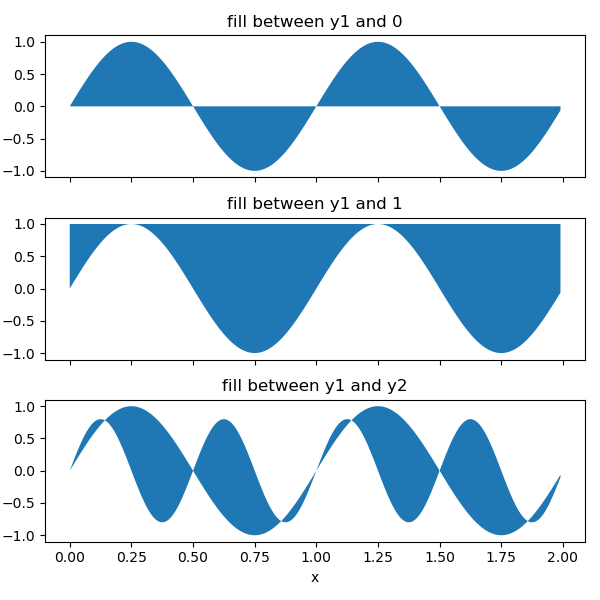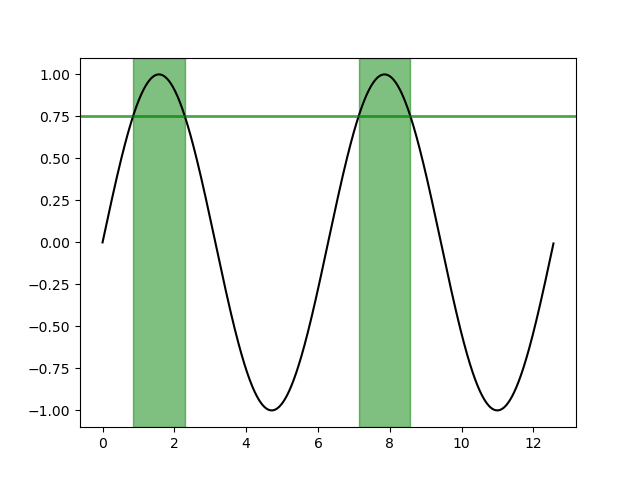Note
Click here to download the full example code
Filling the area between lines¶
This example shows how to use fill_between to color the area
between two lines.
import matplotlib.pyplot as plt
import numpy as np
Basic usage¶
The parameters y1 and y2 can be scalars, indicating a horizontal boundary at the given y-values. If only y1 is given, y2 defaults to 0.
x = np.arange(0.0, 2, 0.01)
y1 = np.sin(2 * np.pi * x)
y2 = 0.8 * np.sin(4 * np.pi * x)
fig, (ax1, ax2, ax3) = plt.subplots(3, 1, sharex=True, figsize=(6, 6))
ax1.fill_between(x, y1)
ax1.set_title('fill between y1 and 0')
ax2.fill_between(x, y1, 1)
ax2.set_title('fill between y1 and 1')
ax3.fill_between(x, y1, y2)
ax3.set_title('fill between y1 and y2')
ax3.set_xlabel('x')
fig.tight_layout()

Example: Confidence bands¶
A common application for fill_between is the indication of
confidence bands.
fill_between uses the colors of the color cycle as the fill
color. These may be a bit strong when applied to fill areas. It is
therefore often a good practice to lighten the color by making the area
semi-transparent using alpha.
N = 21
x = np.linspace(0, 10, 11)
y = [3.9, 4.4, 10.8, 10.3, 11.2, 13.1, 14.1, 9.9, 13.9, 15.1, 12.5]
# fit a linear curve an estimate its y-values and their error.
a, b = np.polyfit(x, y, deg=1)
y_est = a * x + b
y_err = x.std() * np.sqrt(1/len(x) +
(x - x.mean())**2 / np.sum((x - x.mean())**2))
fig, ax = plt.subplots()
ax.plot(x, y_est, '-')
ax.fill_between(x, y_est - y_err, y_est + y_err, alpha=0.2)
ax.plot(x, y, 'o', color='tab:brown')

Out:
[<matplotlib.lines.Line2D object at 0x7f73b7d201c0>]
Selectively filling horizontal regions¶
The parameter where allows to specify the x-ranges to fill. It's a boolean array with the same size as x.
Only x-ranges of contiguous True sequences are filled. As a result the
range between neighboring True and False values is never filled. This
often undesired when the data points should represent a contiguous quantity.
It is therefore recommended to set interpolate=True unless the
x-distance of the data points is fine enough so that the above effect is not
noticeable. Interpolation approximates the actual x position at which the
where condition will change and extends the filling up to there.
x = np.array([0, 1, 2, 3])
y1 = np.array([0.8, 0.8, 0.2, 0.2])
y2 = np.array([0, 0, 1, 1])
fig, (ax1, ax2) = plt.subplots(2, 1, sharex=True)
ax1.set_title('interpolation=False')
ax1.plot(x, y1, 'o--')
ax1.plot(x, y2, 'o--')
ax1.fill_between(x, y1, y2, where=(y1 > y2), color='C0', alpha=0.3)
ax1.fill_between(x, y1, y2, where=(y1 < y2), color='C1', alpha=0.3)
ax2.set_title('interpolation=True')
ax2.plot(x, y1, 'o--')
ax2.plot(x, y2, 'o--')
ax2.fill_between(x, y1, y2, where=(y1 > y2), color='C0', alpha=0.3,
interpolate=True)
ax2.fill_between(x, y1, y2, where=(y1 <= y2), color='C1', alpha=0.3,
interpolate=True)
fig.tight_layout()

Note
Similar gaps will occur if y1 or y2 are masked arrays. Since missing values cannot be approximated, interpolate has no effect in this case. The gaps around masked values can only be reduced by adding more data points close to the masked values.
Selectively marking horizontal regions across the whole Axes¶
The same selection mechanism can be applied to fill the full vertical height of the axes. To be independent of y-limits, we add a transform that interprets the x-values in data coorindates and the y-values in axes coordinates.
The following example marks the regions in which the y-data are above a given threshold.
fig, ax = plt.subplots()
x = np.arange(0, 4 * np.pi, 0.01)
y = np.sin(x)
ax.plot(x, y, color='black')
threshold = 0.75
ax.axhline(threshold, color='green', lw=2, alpha=0.7)
ax.fill_between(x, 0, 1, where=y > threshold,
color='green', alpha=0.5, transform=ax.get_xaxis_transform())

Out:
<matplotlib.collections.PolyCollection object at 0x7f73b784a5b0>
References¶
The use of the following functions, methods and classes is shown in this example:
Out:
<function _AxesBase.get_xaxis_transform at 0x7f73be8d9700>
Total running time of the script: ( 0 minutes 3.125 seconds)
Keywords: matplotlib code example, codex, python plot, pyplot Gallery generated by Sphinx-Gallery